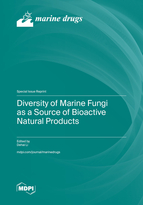Diversity of Marine Fungi as a Source of Bioactive Natural Products
A special issue of Marine Drugs (ISSN 1660-3397). This special issue belongs to the section "Structural Studies on Marine Natural Products".
Deadline for manuscript submissions: closed (8 October 2023) | Viewed by 18535
Special Issue Editor
Interests: marine natural products; drug discovery; biosynthesis; medicinal chemistry
Special Issues, Collections and Topics in MDPI journals
Special Issue Information
Dear Colleagues,
Bioactive metabolites from marine-derived fungi are known to be an important source for drug discovery. Natural product scientists have explored various environments, such as deep ocean, polar regions, as well as marine mangrove ecosystems, to discover unique fungi strains which have the ability to produce new bioactive structures.
The aim of this Special Issue is to highlight the diversity of fungi derived from different marine environments as well as their potential as producers of bioactive marine natural products. Innovative scientific results as well as approaches and methodologies applied in marine natural product discovery areas are encouraged. Studies on the biosynthesis and bioactivities of marine natural products are also welcome.
For this Special Issue, we invite academic and industry scientists to submit reviews and original and conceptual research articles highlighting diversified marine fungi as a source of bioactive natural products.
Prof. Dr. Dehai Li
Guest Editor
Manuscript Submission Information
Manuscripts should be submitted online at www.mdpi.com by registering and logging in to this website. Once you are registered, click here to go to the submission form. Manuscripts can be submitted until the deadline. All submissions that pass pre-check are peer-reviewed. Accepted papers will be published continuously in the journal (as soon as accepted) and will be listed together on the special issue website. Research articles, review articles as well as short communications are invited. For planned papers, a title and short abstract (about 100 words) can be sent to the Editorial Office for announcement on this website.
Submitted manuscripts should not have been published previously, nor be under consideration for publication elsewhere (except conference proceedings papers). All manuscripts are thoroughly refereed through a single-blind peer-review process. A guide for authors and other relevant information for submission of manuscripts is available on the Instructions for Authors page. Marine Drugs is an international peer-reviewed open access monthly journal published by MDPI.
Please visit the Instructions for Authors page before submitting a manuscript. The Article Processing Charge (APC) for publication in this open access journal is 2900 CHF (Swiss Francs). Submitted papers should be well formatted and use good English. Authors may use MDPI's English editing service prior to publication or during author revisions.
Keywords
- marine fungus
- bioactivity
- natural products
- biosynthesis
- cytotoxicity
- antimicrobial activity
- deep sea







